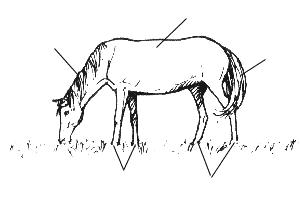The cutting tool becomes dull in the process of working with wood. A dull tool crushes the wood, making the carving look rough and sloppy. A tool blade sharpened to the required sharpness and tucked in makes the carved product clean and makes work easier. Good master always keeps his tools sharp and ready for use at any time. A properly sharpened tool lasts longer, and vice versa - if there are defects, it quickly becomes unusable. Every woodcarver should be able to sharpen and refuel his tool himself using an electric sharpener, a sharpener with manual drive or manually.
Sharpening and straightening on an electric sharpener. The fastest and most convenient way is to sharpen and refuel a tool using an electric sharpener with various accessories. The most convenient is an electric sharpener, on the motor shaft of which you can install replaceable abrasive and finishing wheels on both sides - rubber with abrasive and felt (Fig. 75).
Rice. 75.
Electric sharpener for sharpening and dressing tools:
a - modernized double-sided sharpener with devices for sharpening, straightening and polishing tools: 1 - sliding stop; 2 - felt circle, 3 - protective screen; 4 - abrasive wheel; 5 - engine; 6 - movable ulor device: 1 - clamp horizontal movement; 2 - movable platform for selecting the sharpening angle; 3 - vertical movement fixing bolt; b - device for straightening and fitting the tool (diagram): 1 - electric motor; 2 - belt drive; 3 - felt circles; 4 - wooden circles for corners; 5 - rubber wheels with abrasive; 6 - bearings; 7 - metal frame; 8 - movable stop; 9 - shaft
Before you start work, you need to prepare everything you need. A woodcarver constantly needs a variety of chisels, for sharpening and refilling of which you need to have a large set of abrasive wheels. For profile chisels (corners, semicircular and flat) you need appropriate circles, which you can make yourself by giving them the desired profile using a piece of an abrasive wheel of increased hardness.
The emphasis on the electric sharpener must be movable so that it can be moved in vertical and horizontal directions. The platform on the stop should also change the angle of inclination or you need to have several platforms with different angles. Place a container of water next to the sharpener.
Tool sharpening techniques. To master correct technique and techniques for sharpening a tool blade, you must adhere to certain rules. First, install a suitable abrasive wheel and determine desired angle sharpen the blade, secure the stop and platform so that there are no vibrations or even slight displacements, turn on the electric motor and begin sharpening. The basis for proper sharpening of a tool is chamfering (Fig. 76).

Rice. 76.
Chamfering:
a - on straight chisels; b - on semicircular and sloping chisels: 1 - external chamfer; 2 - internal chamfer; c - on corner chisels: 1 - internal chamfer; 2 - external chamfer
When grinding a chamfer, take the handle of the chisel in right hand(Fig. 77), and with your left hand hold it in the middle part and lightly press the blade against the abrasive wheel. It is necessary to ensure that the chamfer is sharpened evenly in one plane over the entire width; to do this, the chisel blade is shifted from left to right and back. Semicircular and flat chisels are rotated evenly during sharpening. It is necessary to constantly lower the chisel blade into water, otherwise you can burn out the blade and the chamfer will become wrinkled. Such a tool becomes unusable; you have to grind off a lot of metal, which shortens the length of the chisel blade.

Rice. 77.
Position of the chisel when sharpening (arrows indicate the direction of movement of the chisel):
1 - straight chisel: 2 - semicircular and sloping; 3 - corner chisel
When burrs appear, replace the coarse-grained abrasive wheel with a fine-grained one and sharpen the chamfer, making the burr completely invisible. Then the chisel is finally adjusted on a thick felt circle with GOI paste. If there is no paste, you can replace it with chromium oxide oil paint or prepare it yourself from 80 parts of chromium oxide, 12 parts of wax or paraffin, 3 parts of kerosene and 5 parts of fat. The dressing paste is rubbed into the felt circle evenly around the entire circumference.
Since the tool becomes dull during the carving process, from time to time it has to be re-threaded on felt wheels. It is advisable to have a device (see Fig. 75), on the shaft of which felt wheels with profile shapes and finishing wheels for polishing the surfaces of chisels are attached. To fill the corners, use wooden circles, carved from linden or other soft wood, coated with dressing paste.
Polish the tool on finishing wheels (rubber with abrasive or corundum). But the chisel blade itself cannot be polished on finishing wheels, as it becomes rounded and blunt. To sharpen and refuel the tool, you can adapt an electric drill, using it as an electric sharpener.
Sharpening and dressing of tools by hand is possible with a set of simple and profiled whetstones of varying hardness and grain size, as well as profiled and simple whetstones.

Rice. 78.
Hand sharpener:
1 - factory-made; 2 - homemade
For convenience and speed of sharpening and straightening, you can use a hand sharpener (Fig. 78) or make the device shown in Fig. 79, however, in some cases you have to hold the whetstone in your hands, which is not very convenient.

Rice. 79.
Device for sharpening and dressing tools manually
Wooden boards with bars and whetstones inserted or glued into them can be coated with waterproof varnish or impregnated with hot wax, mastic or paraffin to prevent cracking and unsticking, since the whetstones and whetstones are moistened with water during tool sharpening.
The tool is first sharpened on a coarse-grained whetstone, then on a fine-grained one and straightened on a whetstone, micro-corundum stone, canvas or leather belt with GOI paste, or on a dressing board with diamond or dressing paste.
Sharpening a joint. Knives and chisels are sharpened with a bevel angle from 30 to 80°, depending on the complexity of the carved ornament, its depth, size and curvilinear shape (Fig. 80). The bevel and chamfer angle on both sides of the blade can be obtained using a manual sharpener. Then sharpening and refueling are carried out on whetstones and whetstones.

Rice. 80.
Sharpening a joint with one bevel:
a - sharpening parameters: 1 - chamfer; 2 - sock; 3 - blade; 4 - heel; 6 - hand position when working
During sharpening, the knife or chisel is held so that the entire plane of the chamfer is adjacent to the block. Sharpen the joint with smooth and even movements, directing it back and forth or in a circle along the plane of the block until a thin burr appears on the edge of the blade. After this, they sharpen another bevel of the jamb, turning it over until the burr falls off completely. When processed on a fine-grained stone, the chamfers become completely smooth.
Then the joint is edited on a micro-corundum whetstone in the same sequence as on a block. After straightening, finishing is carried out on a straightening board or leather belt with diamond or GOI filling paste.
The jamb can also be sharpened in another way: on the wide chamfers of the jamb, a second chamfer is ground off near the blade; it is faster and more convenient to thread it during operation (Fig. 81).

Rice. 81.
Sharpening a double bevel jamb:
1 - first chamfer, 2 - second chamfer
Check the sharpness of the joint on a pine or spruce board by making cuts across the grain of the wood. If the blade enters the wood easily and the cut is smooth, without breaking the fibers, the joint is sufficiently sharpened.
Sharpening straight chisels
Straight chisels are sharpened and straightened in the same way as a jamb, but if a burr appears on the chamfer, the blade of the chisel is not turned over, but continues to be sharpened on a fine-grained whetstone and finished on a whetstone. Finishing is carried out on a straightening board or belts with GOI paste (Fig. 82).

Rice. 82.
Sharpening a straight chisel:
1 - hand position; 2 - correct tilt of the chisel when sharpening a chamfer; 3 - incorrect tilt of the chisel
Sharpening and straightening profile chisels. Profile chisels are sharpened on a board with a set of whetstones and whetstones having a suitable profile (Fig. 83). The internal surfaces of chisels are processed with smooth movements back and forth along the length of the block or whetstone; They also sharpen the bevels of the chisel, turning it from side to side until the burr falls off. Having received smooth surface on a fine-grained whetstone, the chisel is adjusted on a belt or straightening board coated with dressing or diamond paste.

Rice. 83.
Sharpening and straightening a profile chisel:
1 - board with a set of profile bars and touchstones; 2 - straightening board with chisel profiles; 3 - leather or canvas belt for straightening
Sharpening and setting saws. In carving, you have to work a lot with various saws (hacksaws, bow saws and others), which need to be sharpened and sharpened quite often. Dull saws make work much more difficult.
In Fig. 84 presents several devices for quickly sharpening saws.

Rice. 84.
Tools for sharpening saws:
a - clamp in a vice: 1 - saw; 2 - wooden spacers; 3 - file with rubber tip; b - wedge clamp: 1 - saw; 2 - wedge clamp

Rice. 84 (continued). Devices for sharpening saws: clamp to a workbench with clamps: 1 - file; 2 - gaskets; 3 - saw; 4 - clamps; g - clamp for bow saw
If the saw hits a stone, nail or other metal object, then one side of the teeth or several teeth become shorter. Because of this, the pipa “moves” away from the desired direction, so damaged teeth must be aligned - milled (Fig. 85).

Rice. 85.
Tool for aligning saw teeth:
a - with a triangular file; b - with a rectangular file: 1 - saw; 2 - file; 3 - block; 4 - wedge; 5 - rubber hose
The correct setting of the saw teeth is also of great importance. Even a sharply sharpened saw does not cut well without cutting. Moreover, each saw is intended for any specific purpose and must have different divorce. Saws with a wide tooth spread are used for working with soft, wet and loose rocks; dense and hardwood requires a small tooth set.
The saws are set using manual and mechanical settings (Fig. 86). The opening angle is adjusted by the width of the wiring slot or by setting the desired inclination in mechanical wiring.

Rice. 86.
Saw layouts:
1 - tooth set; 2 - types of wiring
Having been engaged in wood carving for more than 20 years, being a master of NHP, I decided that it was time to respond to your many requests - to open a wood carving master class on the Amur Jewelry website. Sincerely wanting you to love woodcarving, I begin my lessons with the correct sharpening of the tool and making the handle of the cutter.
Making a cutter handle
I prefer to make handles from hard, tough trees (birch, elm, bird cherry). Take a rectangular block (25x35x130).
At the end of the block we mark the center.
We select a drill bit with a diameter smaller than the shank of the cutter blade and drill a hole.
We insert the blade of the cutter, turn it over and push it all the way in using a mallet.
We begin to cut the handle to the blade of the cutter from the edges and along the plane, making a conical shape.
We remove the chamfer.
We mark the back part with a pencil and cut it at an angle.
We round the back of the handle.
We take medium sandpaper (No. 12) and sand it to a state that is pleasant to us.
We narrow the neck of the handle, gradually cutting off the excess.
We make notches or indentations on the handle.
Apply PVA glue to the neck of the handle and spread it evenly.
To strengthen the neck of the handle, take a nylon thread and carefully wrap it in rings around the part of the handle covered with glue - the neck.
We tuck the end of the thread under the previous turn and apply PVA glue on top in an even layer.
We have created a handle that is convenient for carving, without steps, and smoothly transitions from the blade of the chisel to the blade of the wooden handle.
The cutter is ready for use, after a few hours you can cut wood.
I prefer to make such handles for all working incisors.
Sharpening an oblique knife
We sharpen the tool, in this case the jamb - an oblique knife, on a medium-grained stone (abrasive stone), which is first immersed in water. Having chosen a sharpening angle that is convenient for you, fixing your hands in this position, using light pressure from yourself, we sharpen the tool. The sharpening angle depends on the density of the material you are going to cut.
We sharpen on a medium-grained block until a strip of metal similar to foil appears on the tip of the cutter. We wet the block periodically.
Having achieved, through our labor, a uniform thin strip of foil on the tip, we move on to a small diamond bar.
Using the same movements, we continue sharpening, turning the cutter from one side to the other, until the foil falls away from the cutter tip.
After the diamond block, we apply paste to a moistened leather belt nailed to a wooden block and continue to sharpen (polish) the tip of the cutter to a mirror shine.
A sharpened chisel is checked for readiness in different ways: on the nail, but I usually check by cutting off the edge of a newspaper.
If you succeed, congratulations, your tool is ready to go!
For cutters with one-sided sharpening, one side is sharpened and the other is polished.
That's all! I hope it wasn't difficult for you. See you in the next lesson.
Sculptural composition, work by Novoselov A.V.
To perform all types of carvings, various elements of home decoration, furniture, souvenirs and other crafts, you need a special tool.
Tools for carving can be distinguished as main (cutting) and auxiliary (for drilling and sawing, carpentry, marking). Various electrified household tools and devices based on an electric motor that the master can make himself.
All tools must be of excellent quality so that you can easily carry out carving work of any complexity.
The cutting tool should be made of good steel, light and comfortable, perfectly sharpened so that wood cuts like butter, and it should be kept in perfect condition.
A dull tool crumbles, crushes, and does not cut the wood, and the cuts and the carving itself look rough and careless. This ruins your mood and often discourages you from finishing your work. It’s easy and pleasant to work with a sharp tool; the drawing turns out clean, precise, and beautiful. By finished product You can always determine not only the skill and handwriting of the master, but also how and how he performed the work.
Cutting tool
Bogorodsky knife, it is applied for sculptural carving, takes its name from the Bogorodsk sculptural carvings.
Bogorodsky knife
Knife-jamb(chamfer sharpening angle 20°, bevel angle 35 0;45°;60°), used for flat-notched, flat-relief, relief, openwork carvings.
Knife-jamb
Knife cutter- used as an auxiliary tool for various types threads.
Knife cutter
Straight chisels(sharpening angle 18-20°); used as an auxiliary tool for various types of carvings.
Straight chisel
Semicircular chisels- the main tool used to perform all types of wood carving. There are: - flat (R˃H), medium (R=H), steep (R˂H).
Semi-round chisels
Sameski - cranberries These are chisels with a curved blade which allows, when carving, not to touch the surface being processed with the handle. There is a cranberry-flat chisel and a cranberry-corner. cranberry-semicircular chisel.
Cranberry chisels
Ceramic chisels resemble cool semicircular chisels. The width of their canvas is 2…3 mm. Designed for cutting thin veins, the cross-section of which corresponds to the profile of the tool.
Ceramic chisel
Chisels - corners or geismus.(angle between cutting edges 50-70°). Used to make a V-shaped groove, used to make elements of contour threads.
Corner chisel or Geismus
Stichel. Stichels always have a bend angle of 15 degrees. Their handles are most often in the form of a fungus.Used for sampling various veins when making engravings.
Stichel
Klepiki. The rivets come in the most different sizes, but they have only three forms of sharpening: sword, leaf and nail. The first two are called: sword rivet and leaf rivet.
They are used in flat-relief and volumetric carvings to clean up the background in hard to reach places.
Rivet-sword, rivet-leaf
Chisel-nail. Marigolds differ from ordinary rivets in the shape of their sharpening. It resembles a fingernail to them. The purpose of the marigolds is to clean hard-to-reach places and make elements of staple threads.
Chisel-nail
Spoonmen(spoon knives). The best spoon holder is a sharpened ring with a rod welded to it. Spoons are needed to remove a large amount of material in the recesses and to process the internal walls when making dishes.
Spoonmen
Punches and coins- these are steel rods with a pattern at the working ends. They are most often used for embossing backgrounds in flat-relief and relief carvings.
The cutting tool is made of tool steels:
1-carbon (U10; U12; U10A; U12A), when sharpened, are identified by a white beam of sparks with individual stars.
2-Alloyed (XB5; X12; Ch12M), when sharpened they produce yellow or orange sparks.
3-High-speed steels (P18; P9), when sharpened they give dark red sparks.
Sharpening and dressing tools
Of great importance for performing high-quality wood carving is correct sharpening tool.
Tool sharpening consists of two stages:
1- chamfering;
2- edits.
1. Chamfering. The chamfer can be removed using an electric sharpener (see figure), a manually driven sharpener, or manually using an abrasive stone.
Electric sharpener for sharpening and dressing tools: a - mechanized double-sided sharpener with devices for sharpening, straightening and polishing tools: 1 - movable stop; 2 - felt circle; 3 - protective screen; 4 - abrasive wheel; 5 - engine; b - movable stop device;: 1 - horizontal movement clamp; 2 - movable platform for selecting the sharpening angle; 3 - bolt - vertical movement clamp; c - device for straightening and polishing tools (diagram): 1 - electric motor; 2 - belt drive; 3 - felt circles; 4 - wooden circles for corners; 5 rubber wheels with abrasive; 6 - bearings; 7 - metal frame; 8 - movable stop; 9 - shaft.
The location and movement of the tool during sharpening is shown in the figures.
Chamfering: a - on straight chisels; b - on semicircular and sloping chisels: 1 - external chamfer; 2 - internal chamfer; c - on corner chisels: 1 - internal chamfer; 2 - external chamfer.
Position of the chisel when sharpening: 1 - straight chisel; 2 - semicircular and flat; 3 - chisel - corner;
When sharpening you must:
Maintain the specified sharpening angle;
Maintain the shape of the blade, the chamfer should be smooth without signs of bending;
Blueing of the instrument is not allowed (prevented by periodically wetting the instrument in water).
2. Editing. Tool straightening means increasing the cleanliness of blade sharpening, removing burrs, and improving sharpness. Microcorundum whetstones (Fig.), sandpaper, and leather are used for straightening the instrument.
Sharpening the joint: a - sharpening parameters: 1 -
chamfer; 2 - sock; 3 - blade; 4 - heel;
b - hand position when working;
For semicircular cutters, a dressing board is made from linden, and transverse grooves are made on its surface for cutters of different sizes (Fig.).
Dressing boards and belts
1 - board with a set of profile bars and touchstones;
2 - straightening board with chisel profiles;
3 - leather or canvas belt for straightening.
Before straightening, rub GOI paste into the straightening board. Inner surface semicircular incisors are adjusted with round wooden twigs wrapped in fine sandpaper or leather rubbed with GOI paste. You can edit the instrument on a rotating felt wheel rubbed with GOI paste.
A properly sharpened tool must have a given sharpening angle, blade shape, and be free of burrs.
When cutting across the grain of a pine or spruce board, the cutter should leave a clean cut without breaking the grain.
Literature:
1. Burikov V.G., Vlasov V.N.
House carving - M.: Niva Rossi together with the Eurasian Region Company, 1993-352 p.
2. Vetoshkin Yu.I., Startsev V.M., Zadimidko V.T.
Wooden arts: textbook. allowance. Ekaterinburg: Ural. state forestry engineering univ. 2012.
When working with home tools, you should always keep them in perfect condition. This does not require much effort, but otherwise the work will not progress much. Before sharpening a chisel, you need to carefully familiarize yourself with the options for this work.
Preparation and work activities
Tools and materials:
- stones;
- chisel;
- water or oil;
- leather;
- paste GOI.
Before starting work, you need to clean the chisel from dirt and rust. Sometimes chips appear on a worn-out tool, which also need to be leveled using an emery stone. Otherwise, the result of the activity will be very sad.

Sometimes there are situations when it is impossible to manually remove upper layer from metal, which is why you have to resort to help emery wheel, literally cutting off all the particles from the surface. Usually you have to use this method to remove rust and stubborn dirt.
There are 2 types of whetstones that are used for manual and mechanical sharpening, and each of them has 3 levels (fine, medium and coarse):
- Aquatic. Before use, they are soaked in a water bath for several minutes. This type is most often used in Eastern countries, except for particularly arid ones (Mongolia).
- Oily. Before you start using them, you need to lubricate the stone with oil. Only synthetic petroleum-based oils are used, which is why Westerners have become adherents of this method.
Now you need to properly sharpen the cutter. To do this you need to follow the following sequence:

- Work is in progress on the flat side. The movement occurs evenly forward and backward along the same trajectory, after which the result is mirrored. The movement occurs from the beginning to the very end of the stone so that wear is even.
- Now you can turn the chisel over to work on the main part. The cutter moves over the high-grain stone without jerking, but quite quickly over the entire surface. It is advisable to keep the angle from 20 to 35 degrees, depending on the desired result. If the chisel is needed for cutting work, then a sharp angle will be required, whereas grinding and trimming do not require such a high sharpness.
- After the coarse grain becomes unnecessary (scratches appear), you need to switch to medium, and then, according to the same scheme, to the finest grain. Some craftsmen can sharpen their cutter to such an extent that it cuts paper no worse than a blade (micron sharpening), but this is only necessary when performing special tasks. fine workmanship, so you can get by with just fine grain.
- The chamfer is sharpened. For this, 1.5-2 mm is allocated, which goes under very acute angle(5-7 degrees), but here the quality must be unquestioning. This chamfer is formed in just a few movements, so it won’t take much time.
- At the very end, you will need a piece of leather (it is optimal to have an old leather belt for this purpose), which is rubbed with GOI paste, after which it is straightened with a freshly sharpened chisel. The process itself is performed with your own hands with fairly fast movements, but without much haste, so as not to cut through the skin.
This article is devoted to a process that is relevant for any carver - sharpening. cutting tool. In the previous article I talked about sharpening flat chisels, and here we’ll look at how to properly sharpen semicircular chisels.
The only difficulty in sharpening semicircular chisels or special ones is their shape. This disadvantage can be corrected by doing wooden blocks, the edge of which we plan to the shape of our chisel. Any tree will do; you can protect it from moisture by wrapping it with tape. Ideally, each shaped chisel needs its own individual block, so as not to get confused, you can mark it with numbers.
For the lesson we will need:
- Double-sided silicon oxide block.
- Plywood
- Shaped block
- Abrasive powder
- Sandpaper with abrasive grade R-400, R-800, R-1000, R-2000, I use sandpaper from auto stores.
- Soap solution
- Paste GOI
So, let's begin. We wet our bar soap solution, let it soak and start sharpening. We press the chamfer to the abrasive and begin to make movements as shown in the figure.

Once the burr is formed, we turn our chisel over, and take a shaped block, cut sandpaper for it, you can glue it, or you can simply press it with your hand. I note that the lower the gradation number of the abrasive, the coarser it is: That is, R-400 will be coarser than R-800, etc. I think that a separate article will be devoted to abrasives.

By changing the abrasive, starting from coarse to fine and not forgetting about polishing and straightening the chisel at the end, we achieve it razor sharp. Checking the cleanliness of the cut.
Our lesson has come to an end. I wish you creative success and always sharp chisels.








